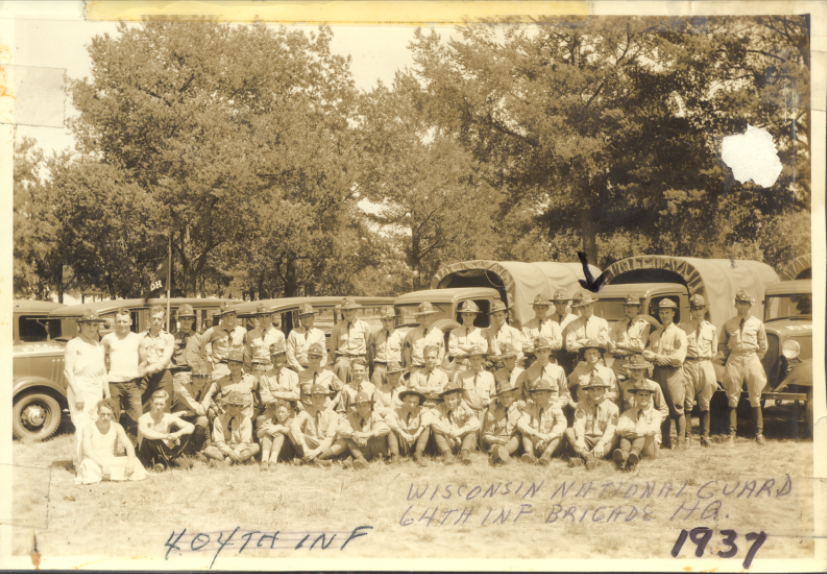La Valle Area
Bernard L. Anderson 1913 - 1997
Bernard L. Anderson
Born - August 21, 1913 La Valle, Wisconsin
Died - December 26, 1997 Panama City, Florida
La Valle, Wisconsin is a long way from the Philippine Islands, but not too far for La Valle native Bernard Anderson to have served his country. Born in La Valle and a graduate of Reedsburg High School Anderson entered the Civilian Conservation Corps in 1934. The Corps whetted his appetite for military service and Anderson joined the National Guard before the call up in 1940.
He was in the Philippines on December 7, 1941 when the Japanese attacked American bases throughout the Pacific and he helped defend the islands during the invasion in early 1942. Under the command of General Douglas MacArthur, American and Philippine forces were trapped by the Japanese on the Bataan peninsula and forced to surrender. Forty thousand American and Philippine soldiers were captured and brutally driven to prison camps during the horrid Bataan Death March. Anderson was not one of them. He evaded capture, escaped from the Bataan bottleneck and into the wild mountains of Luzon. For three and one half years, April 1942 - August 1945, Anderson organized and led a guerrilla force that harassed the Japanese occupiers and gathered intelligence for the promised return of American forces. He built and operated a radio set that acted as a locating station for submarines that brought supplies to his forces. He monitored air battles taking place over the island and rescued twenty-seven pilots who crashed in the jungle.
Although a hunted man with a 50,000 peso bounty on his head, Anderson evaded capture and was never betrayed by the Filipinos. When General MacArthur kept his promise to return to the Philippines, he did it with intelligence help from Anderson. By the time the war ended, Anderson was a Colonel in command of 7,000 guerrillas who aided in the American recovery of the Philippines. He was rewarded with a Presidential Medal of Merit, three distinguished Service Crosses, a Silver Star, a Bronze Star and many other military honors.
After the war Anderson remained in the Philippines and in the United States Air Force Reserve. He held a number of important positions in government and industry until his return to the United States in 1960 where he worked for several engineering firms in the Midwest. By 1979, Anderson and his wife Agnes Thiemann had raised four children and retired to Callaway, Florida. He died in 1997 and was buried in Reedsburg at the Calvary Cemetery.
Few American soldiers spent more time under the threat of death than Bernard Anderson. His heroism was steady, long-lived and vital to American success in World War II. He is a fitting representative for all of Sauk County’s veterans, most of whom had much less exciting military careers, but were equally willing to respond as valorously as Colonel Anderson.
Received a total of 27 medals, ribbons and awards from both USA and Philippines: - Distinguished Service Cross - Silver Star - Bronze Star - Combat Infantry Badge - Nine Overseas Combat Stripes - Army of Occupation Medal with Japan Clasp - Philippine Legion of Honor - Philippine Defense Medal - Philippine Liberation Medal - Philippine Distinguished Service Star - Philippine Medal of Valor
Early Years
by Bob Anderson, son of Bernard Anderson
What prepares a person for War? Bernard Anderson spent his childhood years in Angelo and La Valle, Wisconsin. His father, Ulysses Grant Anderson, supported his wife Lena and 4 children (Harriet, Delia, James, and Bernard) as a local blacksmith. I’m sure his curiosity about his father’s work sparked his interest in how things work and how things are made. This likely was the very beginning of his preparations for war.
As he grew he held several held jobs in the local area. These jobs, along with the influence of many of the people of the La Valle, Angelo, and Sparta communities, helped cultivate the skills to be a successful Guerrilla leader. One in particular providing a key basis for his success – working at the Mill and Power Plant in La Valle for the Duddleson’s. Here he learned the operation and maintenance of various types of equipment the most important of power generation and transfer.
As a young man he joined the Civilian Conservation Corps working on in the forests of Wisconsin. Here, due to his age, he worked as the cook and keeper of the men in his camp. He learned how to hunt, fish, and scavenge to keep the camp running as well as deal with the men to keep things in order, which helped develop his leadership skills. A story he told was that on one particular day, when rations were running short, the other men in the camp went hunting. Upon their return with no game to eat, they found a deer gutted and hanging from a tree near the mess hall. While Bernard was alone at the camp, he saw a deer outside the window. He grabbed a gun and shot it. By the time the others returned, it was dressed and ready for butcher to feed the camp.
After Bernard’s stint in the CCC, he joined the Wisconsin National Guard at Ft McCoy. While stationed at Ft McCoy, he visited nearby Sparta. In the park were some people operating a radio. He was very interested in what they were doing and worked to learn their operation. This was another knowledge that helped prepare him for war.
It is clear that his upbringing and experiences in these small communities of Wisconsin, along with the people who influenced his interests, provided opportunities, mentored, and nurtured him through his youth and early manhood, prepared him for the challenges ahead.









